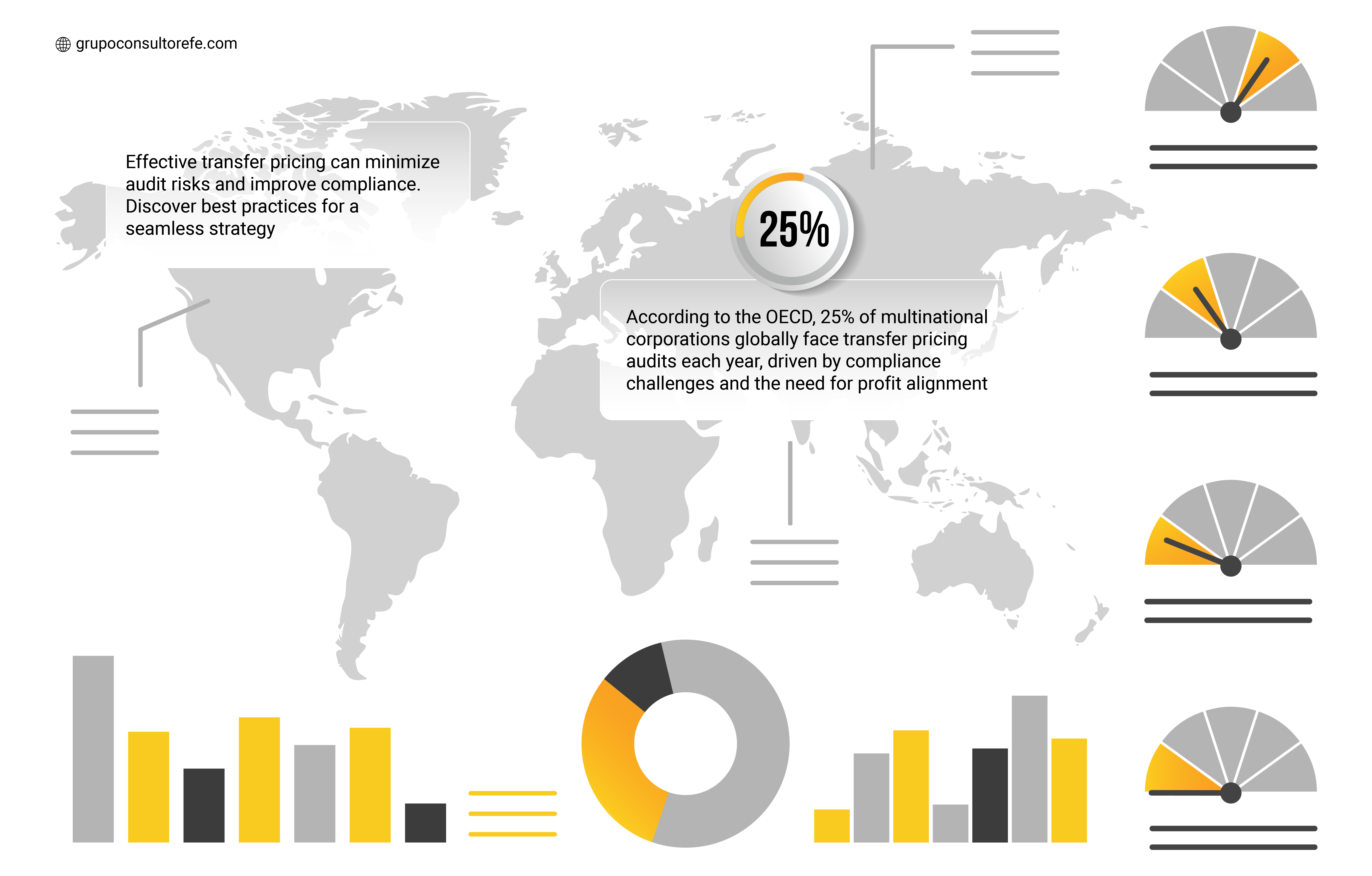
Transfer Pricing
Transfer Pricing Methods: Best Practices for Compliance and Efficiency
Lectura de 5 minutos
Socio
Socio
Transfer Pricing: Definition and importance in global business
Transfer pricing refers to the rules and methods for pricing transactions between related entities within multinational enterprises. These transactions can include the transfer of goods, services, or intellectual property across borders. The concept is vital because it determines how profits are allocated between different tax jurisdictions. Proper transfer pricing ensures that each country receives its fair share of tax revenue and that businesses adhere to local tax laws, avoiding double taxation or tax evasion practices.
Given the rise of globalization, transfer pricing has become a crucial element in international trade, affecting how multinationals structure their operations. By establishing fair pricing for intercompany transactions, businesses can comply with tax regulations in multiple jurisdictions, reducing legal risks and fostering smoother cross-border operations. Failing to comply with transfer pricing regulations can result in heavy penalties, making it a central concern for multinational companies.
Overview of key regulatory bodies and frameworks (e.g., OECD, IRS)
The OECD (Organisation for Economic Co-operation and Development) plays a leading role in creating global guidelines for transfer pricing. The OECD Transfer Pricing Guidelines are widely adopted by many countries as the standard for intercompany pricing, ensuring consistency in how profits are allocated across borders. These guidelines emphasize the arm’s length principle, meaning that transactions between related parties should be priced as if they were between unrelated, independent entities.
In the United States, the Internal Revenue Service (IRS) enforces its own set of transfer pricing rules, which are aligned with the OECD but have specific provisions under IRC Section 482. The IRS focuses on ensuring that multinational companies do not manipulate prices to shift profits to lower-tax jurisdictions. Compliance with both OECD and IRS frameworks is essential for multinational businesses to avoid penalties, double taxation, and scrutiny from tax authorities worldwide.
What is an Example of a Transfer Pricing Method?
Transfer pricing methods are essential for determining the appropriate prices of transactions between related entities. These methods ensure compliance with the arm's length principle, and three of the most commonly used approaches are the Comparable Uncontrolled Price (CUP) method, the Resale Price Method, and the Cost Plus Method. Each of these methods caters to different types of intercompany transactions, offering distinct advantages depending on the industry and type of business structure.

In-depth Exploration of CUP, Resale Price Method, and Cost Plus Method
Comparable Uncontrolled Price (CUP) Method
This method compares the price of a transaction between related parties to the price of a similar transaction between independent parties under similar conditions. The CUP method is highly accurate when there is readily available market data for similar transactions. It’s particularly useful in industries like commodities, where products are homogenous and market prices are easy to access.
This method is highly effective when there is sufficient data on comparable transactions in the open market. The CUP method is frequently applied in industries where product pricing is standardized and publicly available, such as raw materials or commodities. However, finding reliable comparable data can be challenging, particularly when dealing with unique or specialized goods.
Resale Price Method (RPM)
The RPM is used when a company purchases a product from a related party and resells it to an independent party. The transfer price is determined by subtracting a standard resale margin from the price at which the product was sold to the independent buyer. This method is commonly used in distribution companies, where the product sold is not significantly altered before resale.
Cost Plus Method
This method involves determining the transfer price by adding a markup to the costs incurred by the supplier of goods or services in a related-party transaction. It is widely used in manufacturing or service industries where the supplier adds value to the product or service before transferring it to a related entity. The markup must reflect what an independent party would charge in similar circumstances.
Discussion on How to Select the Most Appropriate Transfer Pricing Method Based on Business Structure
Choosing the right transfer pricing method depends on several factors, including the company’s industry, the availability of comparable data, and the nature of the transactions. For businesses operating in highly standardized industries like commodities or financial services, the CUP method often provides the most accurate results. It ensures compliance with tax regulations by closely mirroring market transactions. For a deeper understanding, check out our guide on how to handle related-party transactions with confidence.
In contrast, businesses involved in distribution may find the Resale Price Method more practical, as it is tailored to companies that purchase goods from a related entity and resell them to third parties. On the other hand, the Cost Plus Method works well for manufacturers or service providers where substantial value is added before the final sale. The method selected must align with the business structure, ensuring that it accurately reflects market conditions while complying with global and local transfer pricing regulations.
Fund Transfer Pricing
Fund transfer pricing (FTP) is a method used primarily by financial institutions, such as banks, to evaluate the profitability of different business units by assigning a cost or value to the internal transfer of funds. This system helps financial institutions allocate the costs of borrowing and lending between different departments, such as treasury, retail banking, or corporate lending, ensuring that each unit is accountable for its contribution to the overall profitability.
FTP allows institutions to better manage liquidity, interest rate risks, and capital allocation. By implementing fund transfer pricing, businesses can monitor how efficiently funds are being utilized, optimizing decision-making processes related to pricing loans, deposits, and other financial products.
Relation to Transfer Pricing Tax and Opportunities
In the broader context, fund transfer pricing is closely related to Transfer Pricing tax regulations, especially in multinational corporations where financial institutions operate across multiple tax jurisdictions. Transfer pricing tax ensures that prices for goods, services, or funds transferred within subsidiaries of a multinational corporation are conducted at arm's length, complying with tax laws.
For financial institutions, transfer pricing opportunities arise when they leverage fund transfer pricing mechanisms to manage risks and improve operational efficiency. By aligning FTP strategies with global tax regulations, companies can minimize risks of non-compliance while finding ways to optimize their capital flow. These opportunities can also result in cost-saving measures or more strategic allocation of funds within the organization.
Price Transfer and Fund Transfer Pricing
In the context of fund transfer pricing, price transfer refers to the method of assigning a specific cost to internal transactions between different business units. For example, when one department needs to borrow funds from another, a price is transferred to reflect the cost of accessing those funds. This ensures that each unit bears the responsibility of using those funds efficiently and contributes to the overall financial performance of the institution.
Fund transfer pricing, therefore, acts as a crucial tool in ensuring transparency, accountability, and profitability within financial institutions, while also maintaining compliance with Transfer Pricing tax regulations.
Case studies illustrating the application in real-world scenarios
The following success story explains the importance of a thorough transfer pricing study and how EFE Consulting Group™ played a key role in the successful process of the following company.

Grupo PETSA is a group of companies, originally from Tijuana, that began operations in 1991. From day one, it positioned itself as one of the best suppliers of electrical materials for the local and national markets, achieving significant regional expansion and even reaching an international level with a subsidiary in San Diego, California, in the United States of America.
It is composed of various companies, each playing an important role in positioning the Group as a leader in the industry. As the Group continues to grow, new challenges arise daily, ranging from commercial and marketing matters to fiscal regulation. As a responsible company with a strong sense of compliance and fairness, Grupo PETSA always strives to meet its fiscal obligations.
To achieve this, in 2016, Grupo PETSA turned to the professionals at EFE Consulting Group™ for advice and support on Transfer Pricing for the entire Group. To this day, we are proud to serve as their advisors in this field, ensuring the correct application of Transfer Pricing regulations at all times, as well as efficient financial resource management.
The Transfer Pricing department, together with the accounting and financial team at Grupo PETSA, has managed to comply with the guidelines established by Mexico’s SAT (Tax Administration Service) regarding Transfer Pricing, always in a timely and accurate manner. Additionally, strategies have been developed and solutions implemented that, in addition to meeting all obligations, allow Grupo PETSA to continue its growth efforts, generating operational resource efficiency.
Among the significant results achieved by working optimally with Grupo PETSA, the following stand out:
- Timely compliance with transfer pricing obligations for all national entities.
- Creation of 3 new branches between 2014 and 2018.
- Assistance to 6 national companies and 1 international company.
The Three Types of Transfer Pricing
The very moment we started talking about the three primary types of transfer pricing methods, We need to take into account the following: Transactional, Profit-Based, and Hybrid. Each offers unique approaches to determining the pricing of intercompany transactions, depending on the nature of the goods, services, or intangibles involved.
Explanation of Transactional, Profit-Based, and Hybrid Transfer Pricing Methods
- Transactional Methods: These methods focus on the prices of specific intercompany transactions. The Comparable Uncontrolled Price (CUP) method is one such example, which compares the price charged in a controlled transaction to the price charged in a similar uncontrolled transaction between independent parties. Other transactional methods include the Resale Price Method (RPM) and Cost Plus Method, which evaluate the resale price of a product or the costs incurred plus a profit margin, respectively.
- Profit-Based Methods: These methods assess the profitability of the entire transaction rather than focusing on the price of individual transactions. The Transactional Net Margin Method (TNMM) is a common profit-based method, which compares the net profit margins of related party transactions to those of similar transactions conducted by independent entities. Another example is the Profit Split Method, which allocates profits between related entities based on their relative contributions to the transaction.
- Hybrid Methods: Hybrid methods blend aspects of both transactional and profit-based approaches. These methods aim to balance transaction-level analysis with an overall profitability check, ensuring consistency across the company's global operations. While not as commonly used, hybrid methods provide flexibility when neither purely transactional nor profit-based methods offer a precise solution.
Pros and Cons of Each Method and When to Use Them
Transactional Methods offer high accuracy when comparable transactions can be identified, making them ideal for industries with standard products like commodities. The CUP method, for instance, provides a clear and direct comparison. However, transactional methods can be difficult to apply when no reliable market data is available or when dealing with unique transactions, such as those involving intellectual property.
Profit-Based Methods provide flexibility, especially when transactional data is scarce. The TNMM and Profit Split Method are useful when comparing profitability across different jurisdictions or complex value chains. However, these methods can be less precise, as they rely on aggregated profitability rather than individual transaction prices, potentially leading to disputes with tax authorities regarding the allocation of profits.
Hybrid Methods combine the benefits of both transactional and profit-based approaches but are more complex to apply. They are best used when a company operates in a highly integrated supply chain or when dealing with intangible assets that don't have clear market comparisons. Their complexity can, however, make them more challenging to implement and maintain compliance across jurisdictions.
What is the Transfer Pricing Rule in the US?
Transfer pricing rules in the U.S. are primarily governed by IRS Section 482, which aims to ensure that transactions between related parties, such as subsidiaries of a multinational enterprise, reflect an arm’s length standard. This means that prices set between related parties must be comparable to what would be charged in transactions between independent parties. Section 482 applies to the allocation of income, deductions, credits, and allowances across related entities to prevent tax avoidance by shifting profits to lower-tax jurisdictions.

Overview of US-specific regulations under IRS Section 482
IRS Section 482 is a critical regulation that governs the allocation of income, expenses, and deductions between related entities within the U.S. It ensures that the intercompany pricing of goods, services, and intangibles is consistent with the arm's length principle. This principle requires that the terms and conditions between related entities be the same as those between unrelated entities operating under similar circumstances. Section 482 gives the IRS the authority to adjust pricing and allocation of profits to ensure tax compliance across related parties.
U.S. transfer pricing rules are highly detailed, requiring companies to maintain proper documentation of their pricing strategies. Penalties can be imposed for non-compliance or failure to substantiate transfer pricing policies with relevant data. This regulation aims to prevent companies from shifting profits to low-tax jurisdictions to avoid paying U.S. taxes.
Key differences between US rules and OECD guidelines
Although the U.S. transfer pricing rules under Section 482 align closely with the OECD Transfer Pricing Guidelines, there are some notable differences. The OECD emphasizes the arm’s length principle globally, and many countries have adopted its guidelines. However, the U.S. has specific adjustments, including the use of comparable profits methods (similar to the Transactional Net Margin Method under OECD) and rules surrounding cost-sharing arrangements that are more restrictive than those of the OECD.
One key difference is that the U.S. regulations tend to be more prescriptive and detailed in their requirements for documentation and justification of transfer pricing. Additionally, the IRS places a strong emphasis on economic substance and comparability analyses. While the OECD guidelines provide more flexibility in choosing and applying methods, the U.S. rules are more rigid and focus heavily on data-driven support for intercompany pricing, including more robust penalties for non-compliance. To dive deeper into how these frameworks are evolving and what they mean for businesses worldwide, take a look at this insightful article on the latest OECD Transfer Pricing Guidelines updates.
Pros and Cons of Transfer Pricing
Transfer pricing offers both benefits and challenges for multinational companies. By setting prices for transactions between related entities, businesses can achieve greater tax efficiency and ensure compliance with international and local regulations. However, it is not without its risks. Below, we outline the main advantages and potential downsides.
Advantages such as tax efficiency and compliance benefits
One of the main advantages of transfer pricing is the ability to optimize tax efficiency. By strategically setting prices for intercompany transactions, companies can allocate profits to jurisdictions with lower tax rates, thereby reducing the overall tax burden. This enables businesses to reinvest those savings into growth and operations. Moreover, compliance with transfer pricing rules helps companies avoid hefty penalties and ensures adherence to global tax regulations, particularly in countries following the OECD guidelines. Maintaining proper transfer pricing documentation also demonstrates good corporate governance and transparency, enhancing a company’s credibility.
Additionally, transfer pricing facilitates better financial planning and budgeting for multinational companies, allowing for a clearer allocation of revenues and costs among subsidiaries. By aligning the pricing of transactions with the arm’s length principle, companies can ensure that their tax obligations are spread appropriately across different jurisdictions, reducing the risk of over-taxation.
Potential downsides, including risks of disputes with tax authorities
Despite its advantages, transfer pricing also comes with significant risks. One of the primary downsides is the potential for disputes with tax authorities. Given the complexity of transfer pricing regulations and the variations between countries, businesses may face challenges in aligning their practices with local tax rules, leading to audits, penalties, or costly legal disputes. If a tax authority disagrees with the pricing method used, they may make adjustments that result in higher tax liabilities, additional interest, or fines.
Moreover, the administrative burden of transfer pricing can be substantial. Preparing and maintaining documentation to justify transfer pricing strategies can be time-consuming and resource-intensive, particularly for companies with complex global operations. Inconsistent or inadequate documentation can further expose businesses to penalties and prolonged audits. Additionally, economic volatility or changes in tax laws may impact pricing models, requiring regular reviews and adjustments to ensure continued compliance.
Transfer Pricing in the Digital Economy
The digital economy presents unique challenges for transfer pricing, particularly due to the difficulty in applying traditional methods to digital services and intangible assets like intellectual property and data. Unlike physical goods, digital services and intangibles are often harder to value, and their global reach complicates the allocation of profits across jurisdictions. This creates challenges for tax authorities and businesses alike, as traditional transfer pricing models do not always account for the unique nature of digital transactions. Learn more about economic substance in intercompany transactions and how it aligns compliance and value in this comprehensive article.
Challenges in applying traditional methods to digital services and intangibles
Traditional transfer pricing methods such as the CUP method, Resale Price Method, and Cost Plus Method are often ineffective when applied to the digital economy. Intangibles like software, algorithms, and data analytics do not have readily available market comparisons, making it difficult to apply the arm's length principle. Additionally, digital services are typically provided across multiple jurisdictions without physical presence, further complicating the allocation of profits. As a result, multinational enterprises may struggle to justify pricing models that align with local tax authorities' expectations.
One of the major challenges lies in determining where value is created in the digital economy. In contrast to traditional industries, the generation of value in digital services may involve multiple countries—where development, hosting, and delivery occur—making it difficult to pinpoint the specific location where profits should be taxed.
Recent OECD guidance on digital economy taxation
The OECD has been actively working on solutions for the challenges posed by the digital economy. In 2021, the OECD introduced the Pillar One and Pillar Two proposals, which focus on addressing tax challenges arising from digitalization. Pillar One reallocates a portion of the profits from highly profitable multinational enterprises to market jurisdictions, ensuring that companies pay taxes where they have significant consumer bases, even without physical presence. This approach seeks to account for the complexities of intangible assets and digital services that transcend borders.
Pillar Two introduces a global minimum tax of 15%, aiming to prevent companies from shifting profits to low-tax jurisdictions. This new OECD framework represents a significant shift in international tax policy, ensuring that digital businesses contribute fairly across all markets where they operate. These guidelines help bring clarity to transfer pricing in the digital era, though full implementation across countries may take time.
Transfer Pricing Documentation and Compliance
Transfer pricing documentation is essential for multinational companies to demonstrate that their intercompany pricing practices align with the arm's length principle. Adequate documentation must include details about the company’s business structure, functions performed, risks assumed, and transfer pricing methods applied. This documentation helps prevent disputes with tax authorities and is typically required to be updated annually.
Requirements for maintaining adequate documentation
Tax authorities worldwide expect businesses to maintain comprehensive documentation to support their transfer pricing policies. Companies must provide proof that their pricing reflects market conditions and complies with local tax regulations. Key documentation typically includes a Master File, which outlines the global operations of the multinational group, and a Local File, which details specific transactions within each jurisdiction. Adequate documentation minimizes the risk of tax adjustments, fines, or audits.
Maintaining such records also requires regular updates, ensuring that any changes in business operations or tax regulations are reflected in the company’s compliance materials. Proper documentation not only demonstrates compliance but also acts as a defense in the event of a tax audit.
The role of Country-by-Country Reporting (CbCR) in transfer pricing compliance
Country-by-Country Reporting (CbCR) is a critical component of global transfer pricing compliance, introduced by the OECD’s Base Erosion and Profit Shifting (BEPS) Action 13. CbCR requires large multinational enterprises (MNEs) to provide a detailed breakdown of their income, profits, taxes paid, and other financial activities for each country in which they operate. The report aims to provide tax authorities with a global overview of the company’s operations and ensure that profits are taxed where economic activities occur.
CbCR enhances transparency, allowing tax authorities to assess whether profits are being artificially shifted to low-tax jurisdictions. Non-compliance with CbCR requirements can lead to penalties, making it vital for multinationals to incorporate this reporting into their regular transfer pricing documentation processes.

Transfer Pricing Risk Management
Transfer pricing risk management is essential for multinational enterprises to ensure compliance and avoid costly audits. Companies face significant risks when tax authorities question the accuracy of intercompany pricing or suspect profit shifting. By implementing proactive risk management strategies, companies can safeguard against potential issues and reduce the likelihood of disputes.
Strategies for minimizing risks associated with transfer pricing audits
One of the most effective strategies for minimizing risks is maintaining comprehensive documentation that clearly explains the transfer pricing methods used and justifies their alignment with the arm’s length principle. This documentation must be kept up-to-date and ready for submission during audits. Another key strategy is conducting transfer pricing audits internally to identify potential compliance gaps before tax authorities intervene. This allows companies to adjust their policies and correct any errors before they become costly legal issues.
Regular benchmarking analyses are also vital to ensure that transfer pricing models are consistent with market conditions. This approach allows businesses to stay in line with changes in the industry and adjust their transfer pricing models accordingly.
Importance of aligning transfer pricing policies with overall business strategy
Transfer pricing policies must not be seen as standalone tax measures but should be integrated into the broader business strategy. Aligning pricing policies with the overall structure of the company ensures that they reflect the economic realities of the business, making them defensible during audits. This alignment allows businesses to set pricing that reflects their strategic goals, such as expanding into new markets or optimizing supply chains, while staying compliant with local tax laws.
Moreover, close alignment between operational functions and transfer pricing helps avoid red flags that could trigger audits, such as mismatches between reported profits and real economic activities. Ensuring consistency between business strategies and transfer pricing policies fosters transparency and reduces the likelihood of disputes with tax authorities.
Future Trends in Transfer Pricing
Transfer pricing is continually evolving, especially with the introduction of BEPS 2.0 and the Pillar One and Pillar Two solutions from the OECD. These frameworks aim to address profit shifting by multinational enterprises and ensure that taxes are paid where economic value is created. Pillar One focuses on reallocating profits of large, highly profitable companies to market jurisdictions, while Pillar Two introduces a global minimum tax of 15%, reducing the incentive to shift profits to low-tax jurisdictions.
Impact of BEPS 2.0 and Pillar One and Pillar Two solutions
The BEPS 2.0 initiative, through Pillar One and Pillar Two, is set to dramatically reshape global tax policies. Pillar One’s reallocation of taxing rights to market jurisdictions will impact highly profitable companies, particularly those in the digital economy, as profits will be taxed where consumers and users are located. Pillar Two, introducing a global minimum tax, aims to reduce base erosion by setting a floor on tax competition. Together, these reforms aim to create a more balanced global tax system and prevent aggressive profit shifting.
This will require multinational companies to re-evaluate their transfer pricing strategies, ensuring compliance with these new regulations. Companies will need to assess how profits are allocated across various jurisdictions and ensure they meet the minimum tax thresholds imposed by Pillar Two.
Predictions on how global and US regulations may evolve in response to economic changes
As economic conditions and business models continue to evolve, global and US transfer pricing regulations are likely to become even more stringent. The digital economy, characterized by intangible assets and cross-border transactions, has already posed challenges for existing transfer pricing rules. In response, both global bodies like the OECD and national tax authorities, such as the IRS, are expected to enforce stricter compliance measures and increase scrutiny on digital services and intangible transactions.
The U.S. may adopt elements of the OECD’s Pillar Two by introducing its own version of a global minimum tax, similar to the GILTI (Global Intangible Low-Taxed Income) provisions. Additionally, we could see enhanced transparency requirements and more robust documentation standards to mitigate the risk of tax base erosion and profit shifting as economies shift towards digitalization. Businesses will need to stay agile and adapt to these changes to remain compliant while optimizing their transfer pricing strategies.
Transfer pricing is a critical aspect of international business that ensures fair and compliant transactions between related entities. By understanding and applying the correct methods, maintaining proper documentation, and staying ahead of global trends, companies can mitigate risks and optimize their tax strategies. The introduction of new regulations, such as BEPS 2.0 and the OECD’s Pillar One and Two solutions, will continue to shape the landscape, requiring businesses to adapt.
Key Takeaways
- Importance of compliance with transfer pricing methods.
- Documentation like CbCR is crucial.
- Future trends like BEPS 2.0 will impact global tax policies.
Looking for transfer pricing assistance? Our team of experts at EFE Consulting Group™ can help your business navigate complex regulations, implement effective strategies, and ensure compliance with global tax laws. Reach out today to secure your financial future and optimize your tax management!

